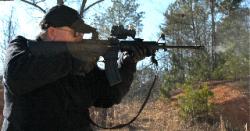Widgetized Section
Go to Admin » Appearance » Widgets » and move Gabfire Widget: Social into that MastheadOverlay zone
Cold Weather Practice
If you live in one of the more temperate climates, the idea of practice in winter clothing probably doesn’t cross your mind. In fact, you might find yourself totally unprepared for the experience.
Yesterday, my lack of thought about the effect of cold weather on my firearms handling was brought to my attention in a way that was, fortunately, only funny and not potentially fatal.
Often failing to work on all aspects of shooting will only become obvious when we find ourselves either in mortal danger or completely out of contention in competition.
I don’t like being either, but I prefer finishing out of the money to the idea of being the guest of honor at a “homegoing celebration”.
Anyway, I have a safe in my basement.
Said basement isn’t heated until the temperatures get really low. Recently, they’ve only been moderately cold and not the ridiculous-cold we had a few weeks ago.
My safe is well-protected against moisture, but the idea of heating, honestly, never crossed my mind. In the south, moisture is the most-likely candidate when it comes to damage to equipment. Humidity means equals rust -and rust is never good. So humidity control is a given here.
Yesterday, however, one of my friends came by to pick up one of my several .22 caliber rifles tricked out in the “modern rifle” furniture. When it comes to getting kids interested in shooting, those rifles seem to resonate with them. Maybe it’s the look – or high-capacity magazines- whatever, they enjoy learning basic shooting skills with them.
As we were pulling long guns from the safe, I noticed something. They weren’t cool to the touch, they were cold.
Cold as in I should have been wearing gloves.
In fewer than five minutes of handling my rifles, my hands were numb and my fine motor tools – my fingers- weren’t capable of anything much at all.

Cool weather shooting: hat, glasses, hearing protection are joined by a jacket capable of stopping cold air while still breathing. The gloves might look like they're unnecessary, but they're not. And a jacket or coat can impact the way you set up on your weapon-practice to see if you need to change your settings for cold weather.
That’s when it occurred to me that there’s more to being prepared for cold weather than simply remembering to stick on a sweater of a jacket.
As an enthusiastic shooter, I sometimes forget to apply one of the basic lessons quickly learned while hunting: have protection from the elements.
Often, forgetting that rule leads to being uncomfortable during range sessions because I’ve forgotten to put in a jacket or gloves or even a head covering that helps prevent heat loss.
If you’re distracted by being too-hot, cold or whatever, performance levels drop- quickly.
That same situation quickly became apparent in what were colder-than-apparent temperatures around my safe.
Without a cold wind, it wasn’t apparent that metals were bone-chillingly cold until I was already handling my gear.
If that had been an emergency, it would more than likely have had a less than desirable outcome. It could have been tragic.
So, I’ve stuck something to the front of that gun safe- a pair of very thin leather gloves. Actually, it’s not a pair of gloves- it’s two golf gloves, a left and a right.
They’re not really suitable for any significant amount of time outdoors, but they’re thin enough to allow me to operate my safe and handle my firearms without completely losing my sense of feeling.
I can still feel control surfaces (safeties, triggers, slides and such) but am insulated from the cold of the bare metal surfaces.
Yesterday, I spent some time loading and unloading magazines, cocking and clearing weapons and and otherwise operating the guns that I consider myself intimately familiar handling.
It was an eye-opening experience. Magazines and ammo moving around in ways I hadn’t anticipated. Some even made it to the floor because I simply didn’t have them adequately under control.
Fortunately, as is my habit, I was loading and unloading magazines that weren’t going into my firearms.
For the firearms practice, I either used empty magazines or used snap-cap type ammunition. When you’re trying to simulate “real” conditions, there is never a reason to shortcut safety. Especially when you’re indoors in your home. There’s just no excuse for forgetting about safety.
As a result of my impromptu practice, I’ve added an extra bit of training time to my practice sessions. A bit of weather-appropriate practice will be added to each range session – and my dry-fire time.
That practice will help me determine what gear I need to have prepared for colder temperatures, how I want it arranged, and what changes – if any- it will make to my emergency planning.
Sometimes, the unexpected lessons are the most valuable.
This time, it was a lesson that will help me be more prepared in the future; not one that could possibly cut my future short because I wasn’t prepared.
–Jim Shepherd
www.shootingwire.com
One Response to Cold Weather Practice
You must be logged in to post a comment Login



 MidwayUSA
MidwayUSA Ruger Firearms
Ruger Firearms SCCY Firearms
SCCY Firearms Streamlight
Streamlight Action Targets
Action Targets Gunsite Academy
Gunsite Academy
Pingback: Cold Weather Practice « Gun Nuts Media